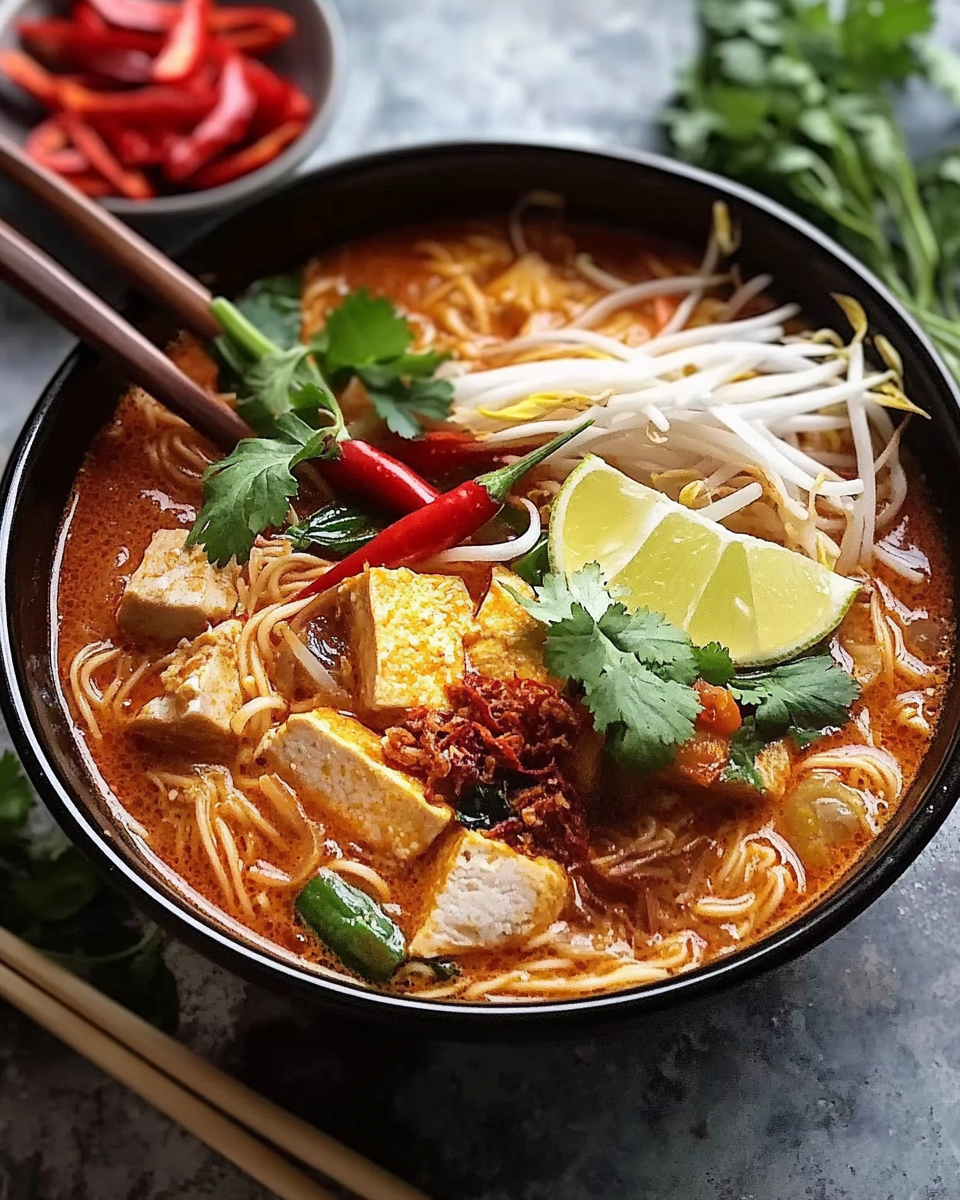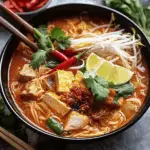This Laksa Soup is a burst of flavor, combining the richness of coconut milk with the heat of red curry paste and the savory goodness of chicken or tofu. Topped with boiled eggs, fresh bean sprouts, and vibrant herbs, each spoonful is an explosion of textures and tastes.
Whether you enjoy a mild or spicy kick, this dish is easily adjustable to your taste. It’s perfect for a warming weeknight meal or an impressive dinner for guests. The combination of tender noodles, creamy broth, and fresh toppings makes it a comforting dish that you’ll want to make over and over again.
Full Recipe:
-
2 tbsp vegetable oil
-
1 onion, chopped
-
3 cloves garlic, minced
-
1-inch piece ginger, grated
-
1 tbsp red curry paste
-
1 can (400 ml) coconut milk
-
4 cups chicken or vegetable broth
-
1 tbsp soy sauce
-
1 tsp sugar
-
200g cooked chicken (shredded) or tofu
-
200g rice noodles
-
2 boiled eggs, halved
-
1 cup bean sprouts
-
2 spring onions, chopped
-
Fresh coriander leaves
-
1 red chili, sliced (optional)
-
Lime wedges
Directions:
-
Heat the vegetable oil in a large pot over medium heat. Add the onion, garlic, and ginger, sautéing for 2-3 minutes until fragrant.
-
Stir in the red curry paste and cook for another 1-2 minutes, allowing the paste to release its flavors.
-
Pour in the coconut milk and chicken broth, bring to a boil, then reduce to a simmer. Add the soy sauce and sugar, stirring to combine.
-
Add the shredded chicken (or tofu) and rice noodles, cooking for 5-7 minutes until the noodles are tender.
-
Serve the soup in bowls, topped with halved boiled eggs, bean sprouts, spring onions, coriander, and sliced chili. Garnish with lime wedges.
Prep Time: 10 minutes | Cooking Time: 20 minutes | Total Time: 30 minutes
Kcal: 350 kcal | Servings: 4 servings
Introduction to Laksa Soup
Laksa Soup is a beloved dish in Southeast Asia, offering a rich and comforting blend of flavors. It is a popular street food in Malaysia, Singapore, and Indonesia, with each region offering its unique twist on the recipe. This soup is known for its aromatic combination of spicy, savory, and creamy elements, creating a deeply satisfying meal that warms both the body and soul. Whether you’re enjoying it as a casual lunch or a hearty dinner, Laksa Soup promises a dynamic culinary experience that reflects the vibrant cultures of the region.
The History of Laksa Soup
The origin of Laksa Soup can be traced back to the 15th century, during the time of the Malacca Sultanate in Malaysia. The dish is said to have been influenced by the Chinese immigrants, particularly the Straits Chinese or Peranakans, who settled in the region. These immigrants, who were a fusion of Chinese and Malay cultures, created Laksa as a way to incorporate local ingredients and flavors into traditional Chinese cooking.
Historically, Laksa was a dish enjoyed by the Peranakan community, often prepared in homes as a special meal during celebrations or gatherings. Over time, the dish became widely popular in Southeast Asia and adapted to the tastes of different regions. In Singapore, Malaysia, and Indonesia, Laksa became a street food staple, with vendors serving up hot bowls of the flavorful soup to eager customers.
Types of Laksa Soup
There are two primary types of Laksa Soup that have become internationally recognized: the creamy and rich Curry Laksa and the tangy and sour Asam Laksa. Both versions share a base of noodles and broth, but the flavors and ingredients vary significantly.
Curry Laksa is characterized by a rich, coconut-based broth spiced with curry paste and often includes chicken, shrimp, or tofu. The noodles used in this version are typically rice noodles, and the dish is garnished with fresh herbs, boiled eggs, and bean sprouts. The creamy coconut milk creates a comforting, velvety texture, while the spicy red curry paste provides a bold kick.
On the other hand, Asam Laksa uses a tamarind-based broth that is tangy and slightly sour, contrasting with the richness of Curry Laksa. This variation often features mackerel or other types of fish, along with thick rice noodles. The tangy broth is what makes Asam Laksa distinctive, providing a refreshing contrast to the heat of the spices.
Health Benefits of Laksa Soup
While Laksa Soup is undeniably indulgent, it also offers a variety of health benefits depending on the ingredients used. Coconut milk, a common base for Curry Laksa, is rich in healthy fats that can help improve cholesterol levels and support heart health. Additionally, the spices in Laksa, such as ginger, garlic, and chili, are known for their anti-inflammatory properties and ability to boost metabolism.
Chicken or tofu, often included in the soup, provide high-quality protein, essential for muscle repair and overall body function. The fresh herbs like coriander and spring onions not only add flavor but also provide essential vitamins and antioxidants. The addition of vegetables such as bean sprouts and spinach in some variations further increases the nutritional value of the dish, offering fiber and essential nutrients that promote digestion and overall well-being.
While Laksa is a rich and flavorful meal, it can also be made healthier by opting for lighter ingredients such as tofu, using less coconut milk, or choosing whole-grain noodles. The combination of spices and fresh ingredients makes Laksa Soup a balanced dish that can nourish both the body and the senses.
How to Make the Perfect Laksa Soup
Creating the perfect bowl of Laksa Soup starts with building a flavorful broth. The key to a rich and aromatic broth lies in the balance of spices and base ingredients. Red curry paste, lemongrass, ginger, garlic, and a dash of fish sauce form the foundation for the base, infusing the soup with bold, aromatic flavors.
When making Laksa Soup at home, it’s important to select high-quality coconut milk to achieve that signature creamy texture. If you’re aiming for a lighter version, consider using a reduced-fat coconut milk or substituting with almond milk for a dairy-free option.
Fresh noodles, typically rice noodles, are a must for this dish as they absorb the broth beautifully and provide a tender texture. For a heartier meal, you can also add protein such as chicken, shrimp, or tofu, depending on your dietary preferences.
For garnishes, a variety of fresh vegetables and herbs are essential. Bean sprouts, fresh coriander, sliced red chilies, and lime wedges add brightness, freshness, and a touch of heat that perfectly complements the rich soup.
Tips for Making the Best Laksa Soup
To get the most flavorful Laksa Soup, there are a few tips to keep in mind. First, always cook the curry paste and spices in oil to release their full flavors before adding the liquids. This step intensifies the taste and ensures a well-balanced broth.
Second, let the broth simmer for at least 15-20 minutes to allow the spices to meld together. The longer it simmers, the richer and deeper the flavors will become. If you’re in a hurry, you can use pre-made curry paste, but making your own paste from scratch will yield the best results.
Lastly, don’t forget to add the fresh garnishes just before serving. The contrast between the hot soup and the cool, crunchy garnishes elevates the dish and adds an extra layer of flavor and texture.
Regional Variations of Laksa Soup
While Laksa Soup has a basic structure that remains consistent across variations, regional differences add exciting diversity to the dish. In Malaysia, for example, the Penang Laksa features a tangy tamarind broth and often includes mackerel, while the Nyonya Laksa offers a more complex blend of coconut and spices.
In Singapore, Laksa is traditionally served with thick rice noodles and is often garnished with prawns, chicken, or egg. Singapore Laksa also has a reputation for being particularly spicy, with generous amounts of chili paste used to give the soup an extra kick.
Indonesia’s Laksa, on the other hand, tends to be slightly milder, with a greater emphasis on the rich coconut milk and a more balanced spice profile. It is also not uncommon to see tempeh or tofu added as a protein source in Indonesian Laksa versions.
Why Laksa Soup is a Crowd-Pleaser
Laksa Soup’s combination of flavors, textures, and aromas makes it a universally appealing dish. The complexity of the broth, balanced by the freshness of the toppings, ensures that every bite delivers a delightful contrast. The versatility of the dish allows it to be adapted for various dietary needs, making it a crowd-pleaser for gatherings or family meals. Whether you enjoy it spicy or mild, with chicken or tofu, Laksa Soup offers endless possibilities for customization, ensuring that it will always have a place on your dinner table.
Conclusion
Laksa Soup is more than just a bowl of noodles; it’s a dish rich in history, culture, and flavor. Whether you’re savoring a comforting bowl on a rainy day or impressing guests with its vibrant presentation, Laksa offers an unforgettable taste experience. With its unique blend of spices, creamy coconut milk, and customizable ingredients, Laksa Soup has earned its place as a beloved staple in Southeast Asian cuisine and around the world. Whether you choose the tangy Asam Laksa or the rich Curry Laksa, this dish is sure to satisfy your craving for bold, comforting, and delicious flavors.
Enjoying a bowl of Laksa Soup is not just about indulging in a delicious meal; it’s about experiencing a rich cultural tradition that has evolved over centuries, now shared globally by food lovers everywhere.






